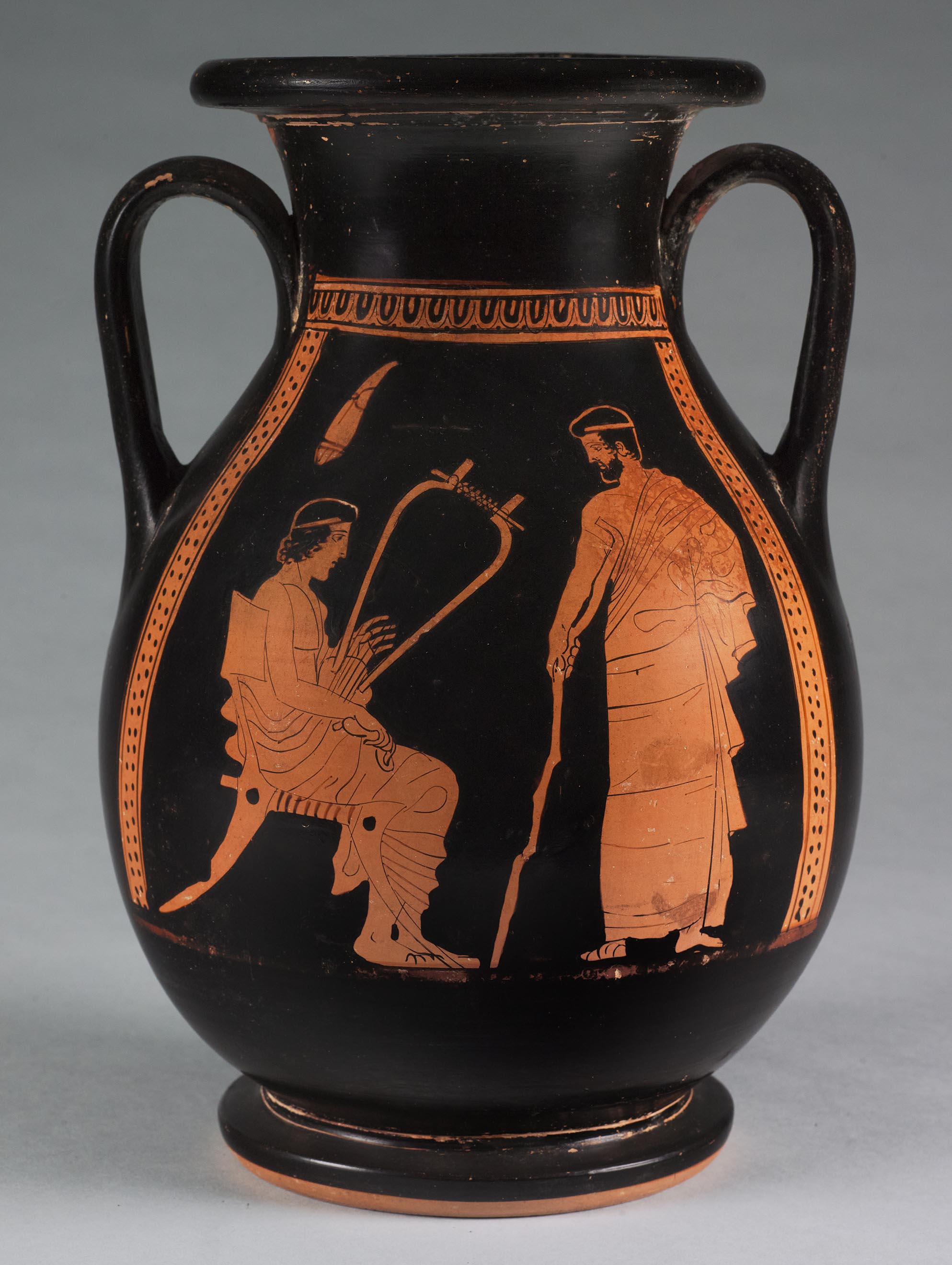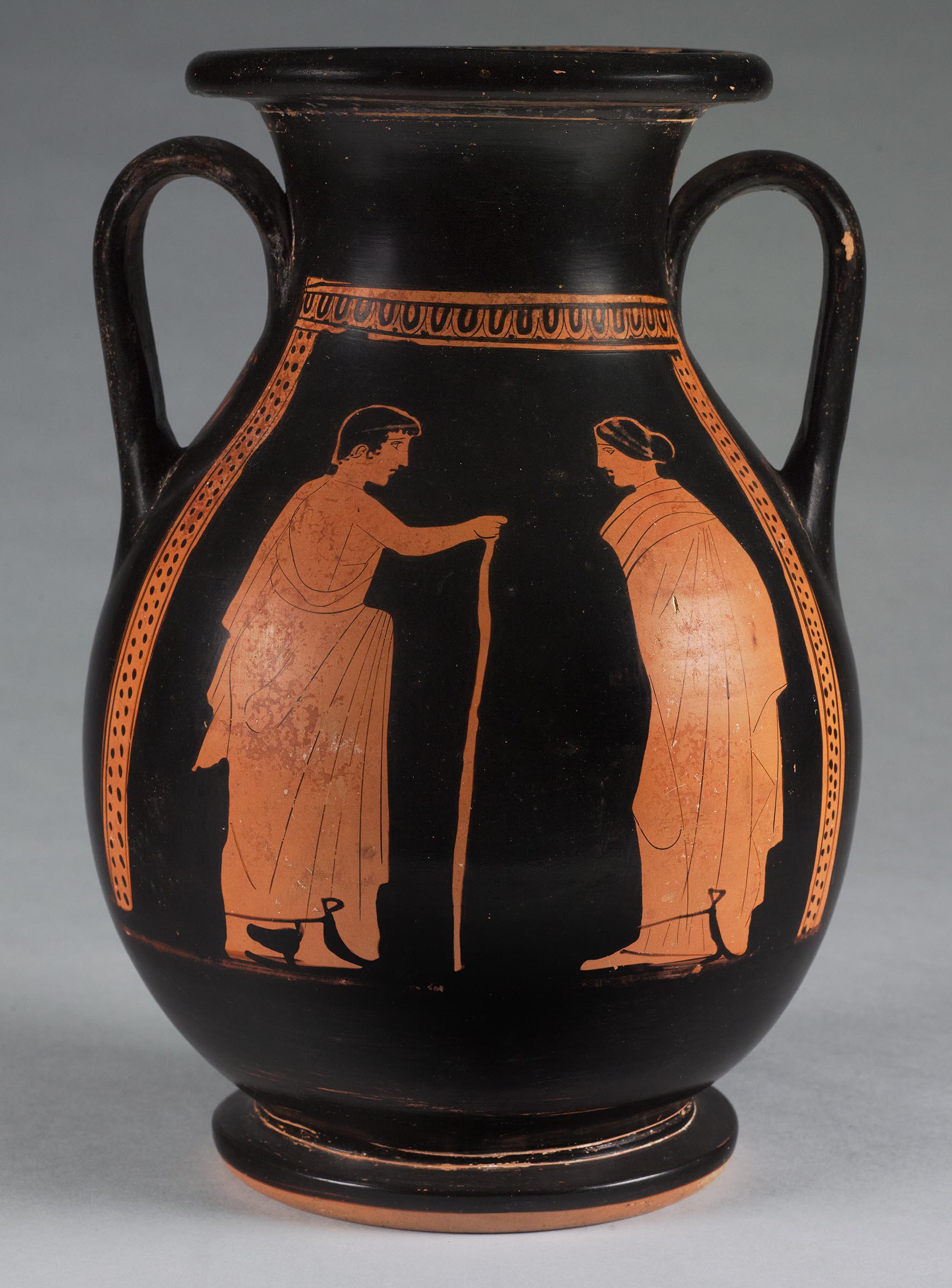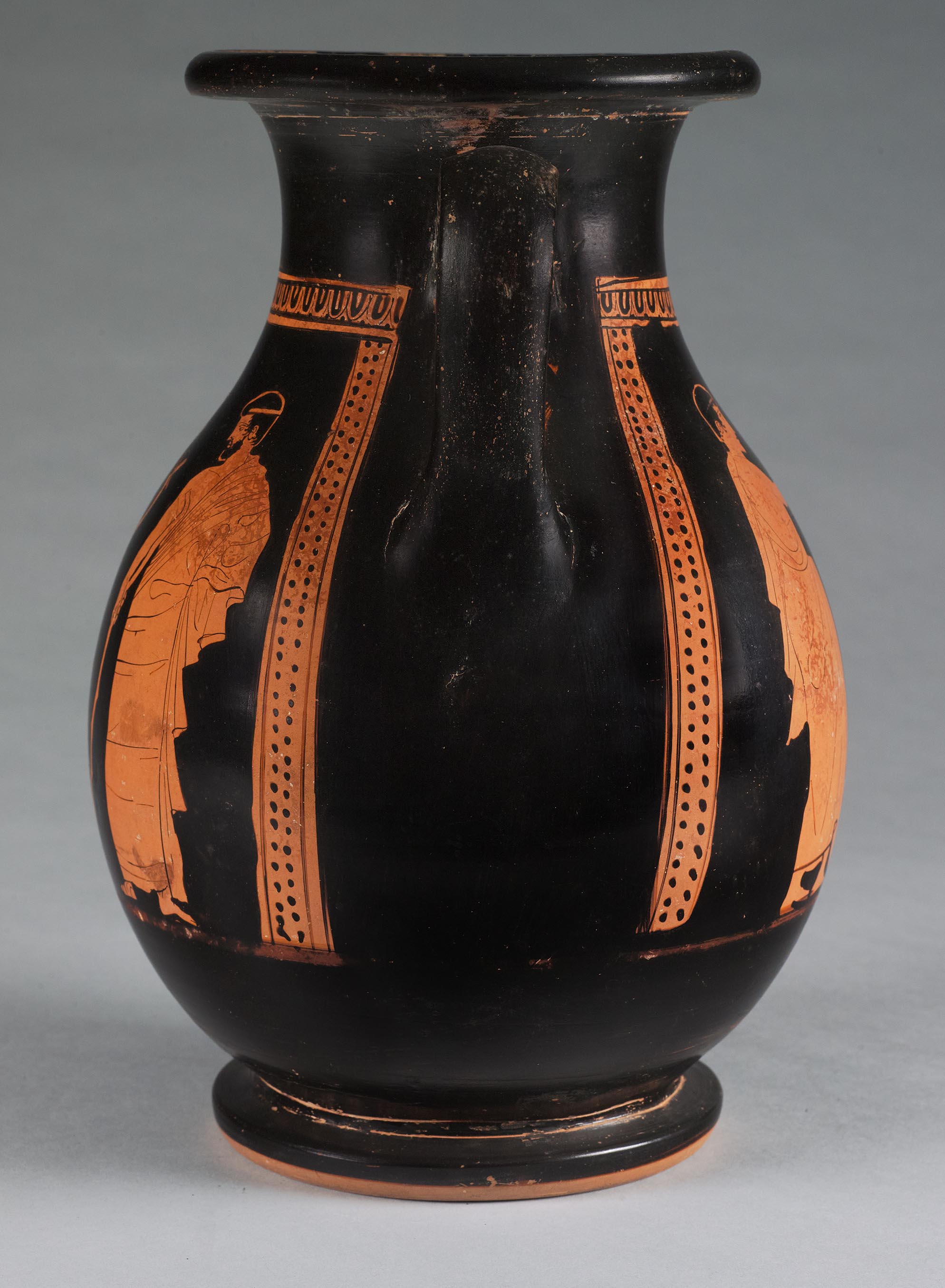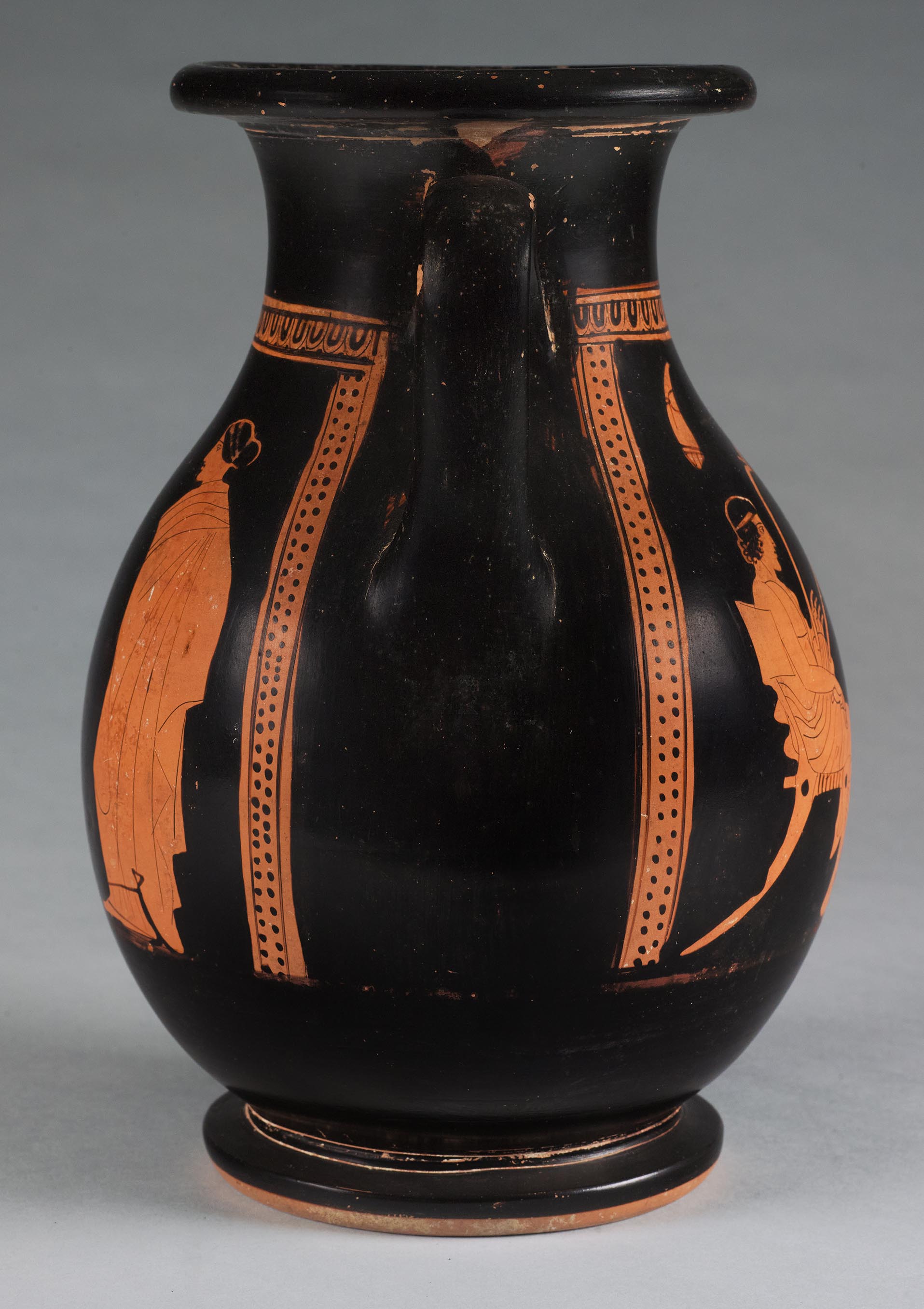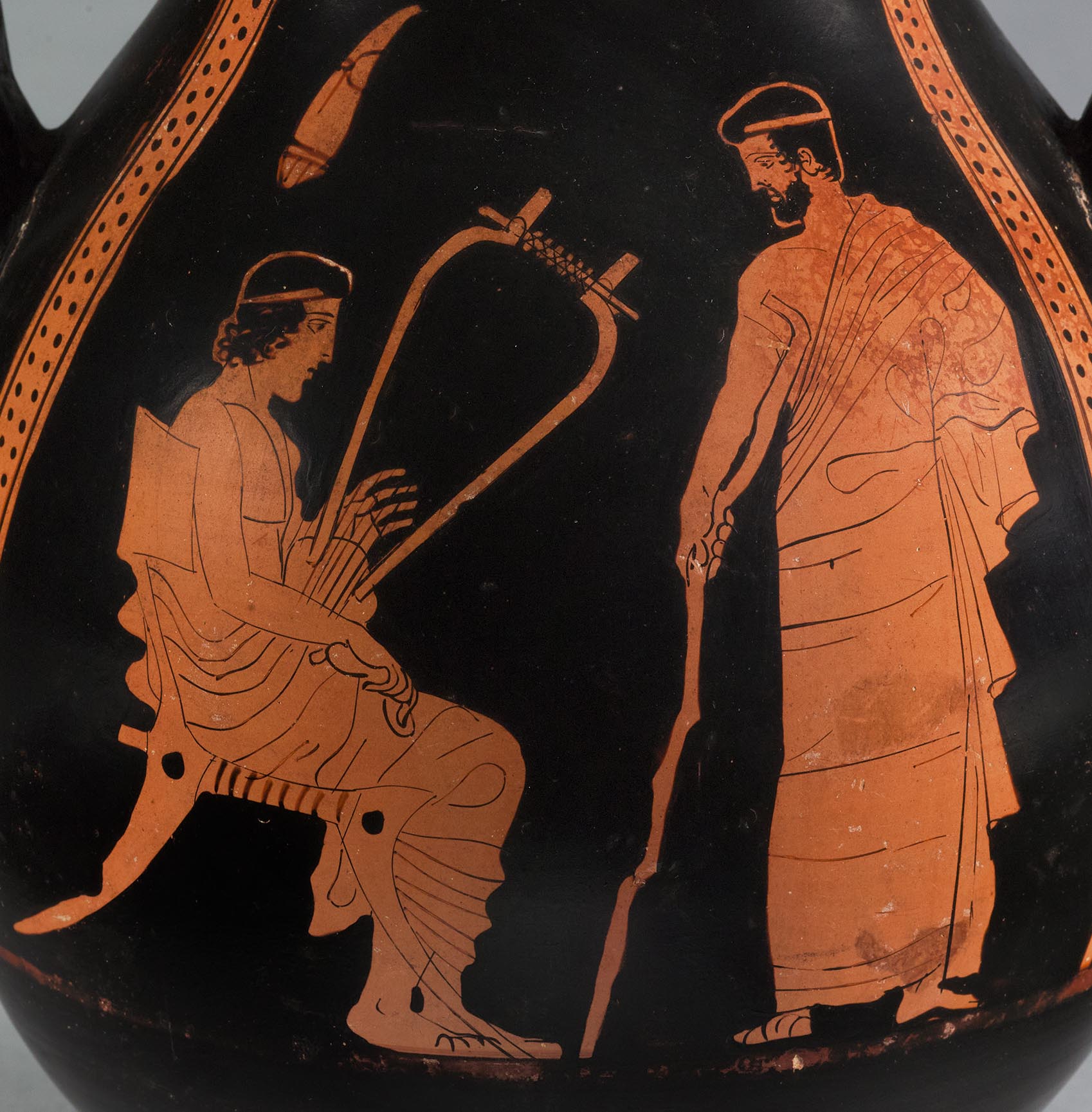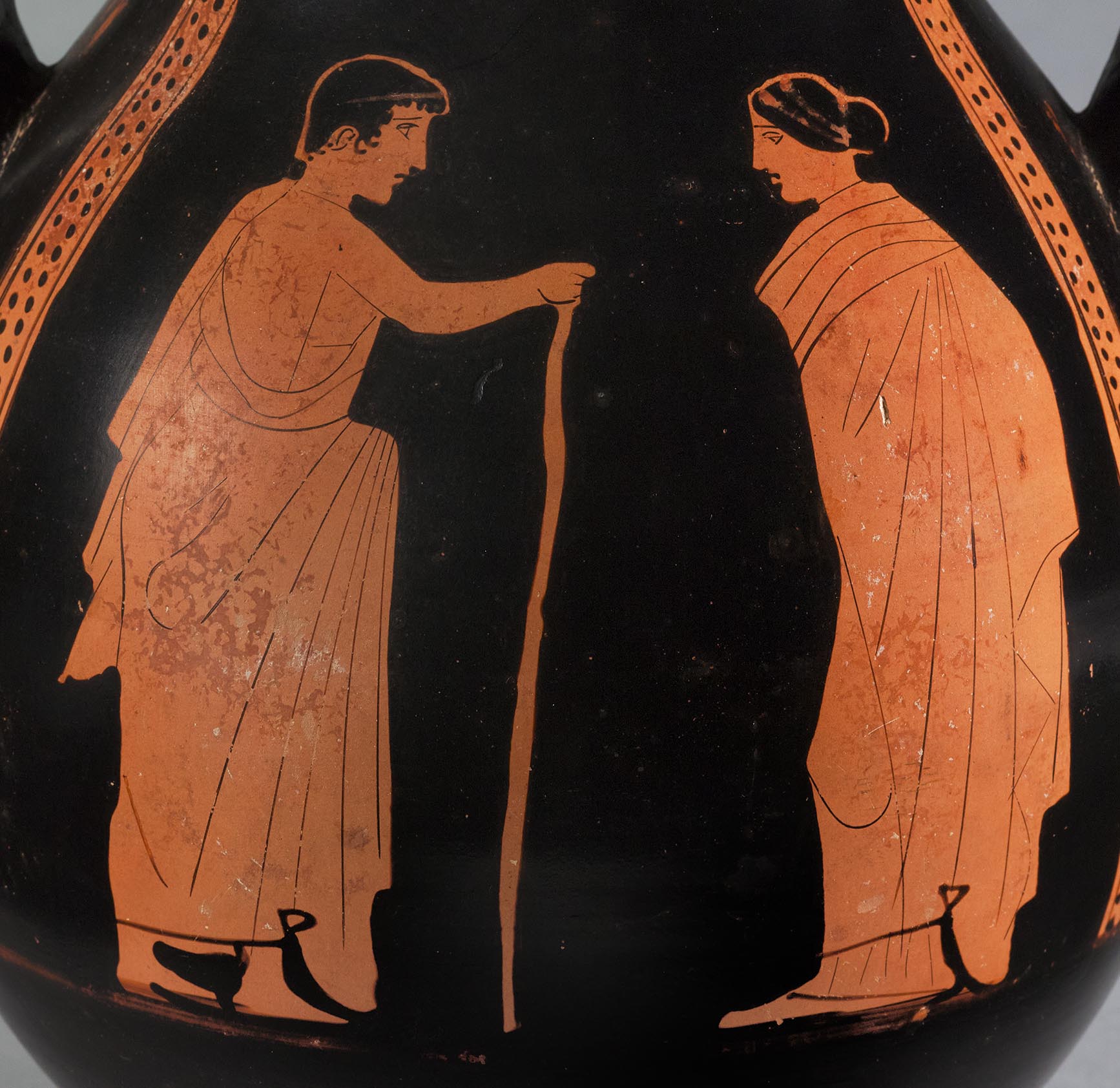Provenance
January 20, 1967, Parke-Bernet Galleries (New York, NY); December 4, 1969, Parke-Bernet Galleries (New York, NY); 1972, Alex G. Malloy, Inc. (New York, NY); 1972, gift, Princeton University faculty to Robert F. Goheen (Princeton, NJ) on his retirement; 2002, gift, Robert F. Goheen to Princeton University.
Shape and Ornament
Torus rim, black. Tall, slender neck. Interior of mouth and neck black. Strap handles black, thicker in middle. Ovoid body, interior reserved, separated from disk foot by a fillet. Top and upper side of foot black; lower half of foot and underside reserved. Shallow concave molding underneath; narrow resting surface (w. 0.35 cm). Figural panels framed above by bands of ovolo and laterally by bands of paired dots. The groundline is a single added red stripe that encircles the vase.
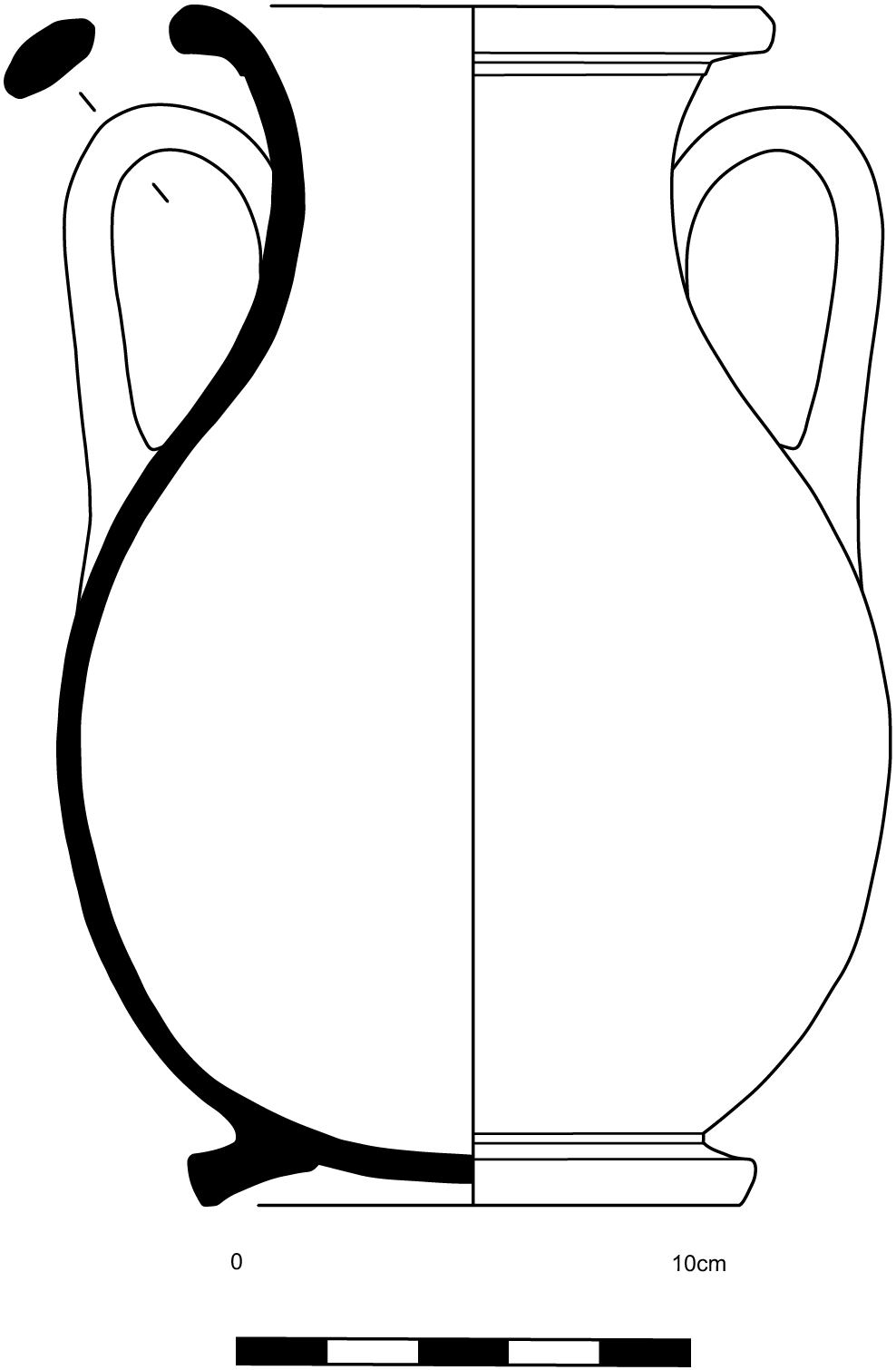
Subject
A. Seated male youth with barbitos and standing bearded male. At left, a male youth, barefooted and wearing a himation that exposes most of his chest, sits on a klismos; his fillet is reserved. He holds a plektron in his right hand and fingers the strings of a barbitos with his left hand. The strings of the barbitos consist of six relief lines. Facing the youth stands a bearded male wearing sandals, a himation, and a reserved fillet. He leans on a knotted staff. A leather phormiskos (bag), tied on the side with a knot, hangs in the field above the youth’s head; it probably contains astragaloi (knucklebones). For more on phormiskoi and astragaloi, see Princeton y1929-203 (Entry 16). Their presence is a sign of the youth’s tender age, as is his counterpoising with an adult male, who may be his teacher or erastes (lover).
B. Standing male youth and standing woman. At left, a standing male youth faces right, wearing a himation and a red fillet. His bare feet are spread, and he holds a stick vertically in his right hand. At right, a woman faces the youth. She is barefoot and wears a long chiton beneath a himation that cocoons her form. Her hair is gathered into a chignon and bound with two red fillets, one of which wraps around the base of the chignon.
Attribution and Date
Attributed to the Naples Painter [J. M. Padgett]. Circa 460–450 BCE.
Dimensions and Condition
h. 26.5 cm; w. 18.5 cm; diam. of mouth 13.6 cm; diam. of foot 12.7 cm. Intact and unbroken. Good surface preservation, with pitting and incrustation largely confined to the interior of the mouth and neck, and the underside of the handles. Incomplete application of black gloss on lip of side B. The figures on both sides exhibit a degree of mottled discoloration; on side A this is largely confined to the standing man, while on side B it is concentrated on the male’s torso, from hip to knee, with lighter discoloration on the female’s body.
Technical Features
Relief contours: the arms of the barbitos. Accessory color. Red: fillets of both figures on side B; encircling groundline. Dilute gloss: cords of the chair seat; details of the phormiskos.
Bibliography
Parke-Bernet Galleries, Antiquities—Egyptian, Western Asiatic, Greek, Etruscan, Roman, Islamic Pottery & Works of Art, auc. cat., January 20, 1967, New York, NY, lot 208; Parke‑Bernet Galleries, Western Asiatic, Egyptian, Greek, Etruscan, Roman Antiquities, auc. cat., December 4, 1969, New York, NY, lot 209; Alex G. Malloy, Catalogue 1, auc. cat. (New York, NY, 1972), no. 54; Abbreviation: Princeton RecordRecord of the Princeton University Art Museum. (1942– ). 62 (2003): 154 [not illus.].
Comparanda
For the Naples Painter, a reasonably prolific painter, primarily of column-kraters and “women’s vases”—loutrophoroi and lebetes gamikoi—see Abbreviation: ARV2J. D. Beazley. Attic Red-Figure Vase-Painters. 2nd ed. Oxford, 1963 1096–1100, 1683; Abbreviation: ParalipomenaJ. D. Beazley. Paralipomena: Additions to Attic Black-Figure Vase-Painters and to Attic Red-Figure Vase-Painters. Oxford, 1971 450–51; Abbreviation: BAdd2Carpenter, T. H., ed. 1989. Beazley Addenda: Additional References to ABV, ARV2, and Paralipomena. 2nd ed. Oxford: Published for the British Academy by Oxford University Press. 328; V. Sabetai, “Red-Figured Vases at the Benaki Museum: Reassembling fragmenta disjecta,” Mouseio Benaki 4 (2004): 15–37. Beazley originally called him the Painter of the Naples Centauromachy (Abbreviation: Att. V.Beazley, J. D. 1925. Attische Vasenmaler des rotfigurigen Stils. Tübingen: Mohr. 409), concluding later that “[h]e continues the tradition of the Florence Painter” (Abbreviation: ARV1Beazley, J. D. 1942. Attic Red-Figure Vase-Painters. Oxford: Clarendon Press. 705). Of the ten or so pelikai attributed to the Naples Painter, most have unframed pictures, whether of this shape—relatively large, with a tall neck and sharply tapering lower body—or smaller and less tapering, like Princeton y978 (Entry 9).
The Naples Painter often depicts lyre players but almost always in the context of a symposion or komos. From the waist up, the young musician walking on a column-krater in Milan is nearly identical to the Princeton youth: Milan A 1871 (G. Arrigoni, ed., Le donne in Grecia [Rome, 1985], 376, pl. 18; Abbreviation: BAPDBeazley Archive Pottery Database. http://www.beazley.ox.ac.uk 16449, with wrong image). The seated lyre player in Princeton is paralleled within his oeuvre only by the seated Orpheus on the column-krater Hamburg 1968.79 (Abbreviation: ParalipomenaJ. D. Beazley. Paralipomena: Additions to Attic Black-Figure Vase-Painters and to Attic Red-Figure Vase-Painters. Oxford, 1971 450.21 ter; Abbreviation: BAPDBeazley Archive Pottery Database. http://www.beazley.ox.ac.uk 275004). Scenes showing a bearded man standing before a seated youth holding a lyre can often be interpreted in conflicting ways, either as music lessons or courtship; e.g., a neck-amphora attributed by Padgett to the Harrow Painter in a Texas private collection (Abbreviation: BAPDBeazley Archive Pottery Database. http://www.beazley.ox.ac.uk 29016). For distinguishing the two, see Abbreviation: Neils and Oakley, Coming of AgeNeils, J., and J. H. Oakley. 2003. Coming of Age in Ancient Greece: Images of Childhood from the Classical Past. Exhibition catalogue. Hood Museum of Art, Dartmouth College. Hanover, NH., 99–104, 244–47. The inclusion of a possible heterosexual courtship scene on the reverse supports a courtship interpretation for side A, although the artist frequently placed a draped woman and youth on the backs of his pelikai and is never explicit about their relationship: cf. Bochum S 512 (Abbreviation: ParalipomenaJ. D. Beazley. Paralipomena: Additions to Attic Black-Figure Vase-Painters and to Attic Red-Figure Vase-Painters. Oxford, 1971 450.55 bis; Abbreviation: BAPDBeazley Archive Pottery Database. http://www.beazley.ox.ac.uk 276107). For homosexual courtship scenes, see G. Koch-Harnack, Knabenliebe und Tiergeschenke: Ihre Bedeutung im päderastischen Erziehungssystem Athens (Berlin, 1983); R. Osborne, The Transformation of Athens: Painted Pottery and the Creation of Classical Greece (Princeton, NJ, 2018), 122–50. On music lessons in general, see T. B. L. Webster, Potter and Patron in Classical Athens (London, 1972), 244–45; Y. Dechavanne, “L’éducation musicale en Grèce des origines à Platon,” Archéologia 56 (1973): 46–49; F. Beck, Album of Greek Education: The Greeks at School and at Play (Sydney, 1975), 23–28; H. Rühfel, Kinderleben in klassischen Athen: Bilder auf klassischen Vasen (Mainz, 1984), 45–53; M. L. West, Ancient Greek Music (Oxford, 1992), 36–38.
The barbitos was a long-armed lyre with a soundbox typically made out of a tortoise shell, resulting in a sound that was less powerful but more appropriate for use indoors: see M. Maas and J. M. Snyder, Stringed Instruments of Ancient Greece (New Haven, CT, 1989), 113–38, figs. 5.1–21; West, Ancient Greek Music, 50, 56–59; Abbreviation: Bundrick, Music and ImageS. D. Bundrick. Music and Image in Classical Athens. Cambridge, 2005, 21–25, figs. 11–13. For the use of the barbitos in the symposion, see ibid., 80–91, figs. 49–56. As young schoolboys typically are represented with a short-armed lyre rather than a barbitos, the youth on the Princeton pelike may be an older boy who is learning to perform at a symposion.
Astragaloi are sometimes included as a sign of youth or childhood: see Abbreviation: Neils and Oakley, Coming of AgeNeils, J., and J. H. Oakley. 2003. Coming of Age in Ancient Greece: Images of Childhood from the Classical Past. Exhibition catalogue. Hood Museum of Art, Dartmouth College. Hanover, NH., 277; L. A. Beaumont, Childhood in Ancient Athens: Iconography and Social History (New York, 2012), 131; M. Golden, Children and Childhood in Classical Athens (Baltimore, MD, 2015), 46–47. Astragaloi were also common courtship gifts: A. Lear and E. Cantarella, Images of Ancient Greek Pederasty: Boys Were their Gods (London, 2008), 63–105. The argument has been made that such sacks in courtship scenes are intended to represent money purses: N. Fisher, “Gymnasia and the Democratic Values of Leisure,” in Kosmos: Essays in Order, Conflict and Community in Classical Athens, eds. P. Cartledge, P. Millett, and S. von Reden (Cambridge, UK, 1998), 97. Phormiskoi and purses, however, are usually rendered quite distinctly: see Princeton y1929-203 (Entry 16).
